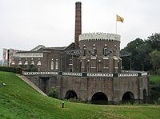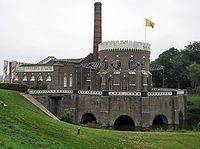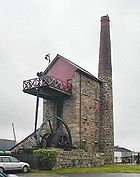
Cornish engine
Encyclopedia

Steam engine
A steam engine is a heat engine that performs mechanical work using steam as its working fluid.Steam engines are external combustion engines, where the working fluid is separate from the combustion products. Non-combustion heat sources such as solar power, nuclear power or geothermal energy may be...
developed in Cornwall
Cornwall
Cornwall is a unitary authority and ceremonial county of England, within the United Kingdom. It is bordered to the north and west by the Celtic Sea, to the south by the English Channel, and to the east by the county of Devon, over the River Tamar. Cornwall has a population of , and covers an area of...
, England, mainly for pumping water from a mine
Mining
Mining is the extraction of valuable minerals or other geological materials from the earth, from an ore body, vein or seam. The term also includes the removal of soil. Materials recovered by mining include base metals, precious metals, iron, uranium, coal, diamonds, limestone, oil shale, rock...
. It is a form of beam engine
Beam engine
A beam engine is a type of steam engine where a pivoted overhead beam is used to apply the force from a vertical piston to a vertical connecting rod. This configuration, with the engine directly driving a pump, was first used by Thomas Newcomen around 1705 to remove water from mines in Cornwall...
that uses steam at a higher pressure than the earlier engines
Watt steam engine
The Watt steam engine was the first type of steam engine to make use of steam at a pressure just above atmospheric to drive the piston helped by a partial vacuum...
designed by James Watt
James Watt
James Watt, FRS, FRSE was a Scottish inventor and mechanical engineer whose improvements to the Newcomen steam engine were fundamental to the changes brought by the Industrial Revolution in both his native Great Britain and the rest of the world.While working as an instrument maker at the...
. The engines were also used for powering man engine
Man engine
A man engine is a mechanism of reciprocating ladders and stationary platforms installed in mines to assist the miners’ journeys to and from the working levels...
s to assist the underground miners' journeys to and from their working levels, for winch
Winch
A winch is a mechanical device that is used to pull in or let out or otherwise adjust the "tension" of a rope or wire rope . In its simplest form it consists of a spool and attached hand crank. In larger forms, winches stand at the heart of machines as diverse as tow trucks, steam shovels and...
ing materials into and out of the mine and for powering the ore stamping machinery
Stamp mill
A stamp mill is a type of mill machine that crushes material by pounding rather than grinding, either for further processing or for extraction of metallic ores. Breaking material down is a type of unit operation....
.
A Cornish engine pumps by a falling weight that is lifted by the engine. Few remain in their original locations, the majority having been scrapped when their related industrial firm closed.
Background: the steam engine in Cornwall
CornwallCornwall
Cornwall is a unitary authority and ceremonial county of England, within the United Kingdom. It is bordered to the north and west by the Celtic Sea, to the south by the English Channel, and to the east by the county of Devon, over the River Tamar. Cornwall has a population of , and covers an area of...
has long had mines for tin
Tin
Tin is a chemical element with the symbol Sn and atomic number 50. It is a main group metal in group 14 of the periodic table. Tin shows chemical similarity to both neighboring group 14 elements, germanium and lead and has two possible oxidation states, +2 and the slightly more stable +4...
, copper
Copper
Copper is a chemical element with the symbol Cu and atomic number 29. It is a ductile metal with very high thermal and electrical conductivity. Pure copper is soft and malleable; an exposed surface has a reddish-orange tarnish...
and other metal ores, but if mining is to take place below adit
Adit
An adit is an entrance to an underground mine which is horizontal or nearly horizontal, by which the mine can be entered, drained of water, and ventilated.-Construction:...
, means must be found of draining water from the mine. This may be done using horse power or a waterwheel to operate pumps, but horses have limited power and waterwheels need a suitable stream of water. Accordingly, the conversion of coal into power to work pumps was highly desirable to the mining industry.
Wheal Vor
Wheal Vor
Wheal Vor was a metalliferous mine about two miles north west of Helston and one mile north of the village of Breage in the west of Cornwall, England, U.K. It is considered to be part of the Mount's Bay mining district. Until the mid–19th century the mine was notable for its willingness to try out...
(mine) had one of the earliest Newcomen engines before 1714, but Cornwall has no coalfield and coal imported from south Wales was expensive. The cost of fuel for pumping was thus a significant part of mining costs. This meant that many early Watt engines were erected by Boulton and Watt
Boulton and Watt
The firm of Boulton & Watt was initially a partnership between Matthew Boulton and James Watt.-The engine partnership:The partnership was formed in 1775 to exploit Watt's patent for a steam engine with a separate condenser. This made much more efficient use of its fuel than the older Newcomen engine...
in Cornwall. They charged the mine owners a royalty based on a share of the fuel saving. The fuel efficiency of an engine was measured by its "duty", expressed in the work (in foot-pounds) generated by a bushel (94 pounds
Pound (mass)
The pound or pound-mass is a unit of mass used in the Imperial, United States customary and other systems of measurement...
) of coal
Coal
Coal is a combustible black or brownish-black sedimentary rock usually occurring in rock strata in layers or veins called coal beds or coal seams. The harder forms, such as anthracite coal, can be regarded as metamorphic rock because of later exposure to elevated temperature and pressure...
. Early Watt engines had a duty of 20 million, and later ones over 30 million.
Development of the Cornish engine
The Cornish engine depended on the use of steam pressure above atmospheric pressure, as devised by Richard TrevithickRichard Trevithick
Richard Trevithick was a British inventor and mining engineer from Cornwall. His most significant success was the high pressure steam engine and he also built the first full-scale working railway steam locomotive...
in the 19th century. Trevithick's early "puffer" engines discharged steam into the atmosphere. This differed from the Watt steam engine, which depended solely on the creation of a vacuum when steam was condensed. Trevithick's later ones (in the 1810s) combined the two principles, starting with high pressure steam but also condensing it in a separate condenser. In a parallel development Arthur Woolf
Arthur Woolf
Arthur Woolf was a Cornish engineer, most famous for inventing a high-pressure compound steam engine. As such he made an outstanding contribution to the development and perfection of the Cornish engine.Woolf left Cornwall in 1785 to work for Joseph Bramah's engineering works in London...
developed the compound engine, in which the steam expanded in two cylinders successively.
When Trevithick left for South America in 1816 he passed his patent
Patent
A patent is a form of intellectual property. It consists of a set of exclusive rights granted by a sovereign state to an inventor or their assignee for a limited period of time in exchange for the public disclosure of an invention....
right to his latest invention to William Sims, who built (or adapted) a number of engines, including one at Wheal Chance (operating at 40 pounds per square inch
Pounds per square inch
The pound per square inch or, more accurately, pound-force per square inch is a unit of pressure or of stress based on avoirdupois units...
above atmospheric pressure
Atmospheric pressure
Atmospheric pressure is the force per unit area exerted into a surface by the weight of air above that surface in the atmosphere of Earth . In most circumstances atmospheric pressure is closely approximated by the hydrostatic pressure caused by the weight of air above the measurement point...
, which achieved a duty of nearly 50 million, but its duty then fell back. A test was carried out between a Trevithick type single-cylinder engine and a Woolf compound engine at Wheal Alfred in 1825, when both achieved a duty of slightly more than 40 million.
The next improvement was achieved in the late 1820s by Samuel Grose, who decreased the heat loss by insulating the pipes, cylinders, and boilers of the engines, improving the duty to more than 60 million at Wheal Hope and later to almost 80 million at Wheal Towan. Nevertheless, the best duty was usually a short-lived achievement due to general deterioration of machinery, leaks from boilers, and the deterioration of boiler plates (meaning that pressure had to be reduced).
Minor improvements increased the duty somewhat, but the engine seems to have reached its practical limits by the mid-1840s. With pressures of up to 50 psi, the shocks are likely to have caused machinery breakages. The same improvements in duty occurred in engines operating Cornish stamps and whims
Whim (mining)
A whim, also called a whim gin or a horse capstan, is a device similar to a windlass used in mining for hauling materials to the surface. It comprises a capstan or a wide drum with a vertical axle. A rope is wound around the drum, with both ends traversing several pulleys and hanging down the mine...
, but generally came slightly later. In both cases the best duty was lower than for pumping engines, particularly so for whim engines, whose work was discontinuous.
The impetus for the improvement of the steam engine came from Cornwall because to the high price of coal there, but both capital and maintenance costs were higher than a Watt steam engine. This long delayed the installation of Cornish engines outside Cornwall. A second hand Cornish engine was installed at East London Waterworks in 1838, and compared to a Watt engine with favourable results, because the price of coal in London was even higher than in Cornwall. However, in the main textile manufacturing areas, such as Manchester
Manchester
Manchester is a city and metropolitan borough in Greater Manchester, England. According to the Office for National Statistics, the 2010 mid-year population estimate for Manchester was 498,800. Manchester lies within one of the UK's largest metropolitan areas, the metropolitan county of Greater...
and Leeds
Leeds
Leeds is a city and metropolitan borough in West Yorkshire, England. In 2001 Leeds' main urban subdivision had a population of 443,247, while the entire city has a population of 798,800 , making it the 30th-most populous city in the European Union.Leeds is the cultural, financial and commercial...
, the coal price was too low to make replacement economic. Only in the late 1830s did textile manufacturers begin moving to high pressure engines, usually by adding a high pressure cylinder, forming a compound engine, rather than following the usual Cornish practice.
Preserved Cornish engines

Kew Bridge Steam Museum
Kew Bridge Steam Museum houses a museum of water supply and a collection of water pumping steam engines. The museum is an Anchor Point of ERIH, The European Route of Industrial Heritage...
in London has the largest collection of Cornish engines in the world. At Crofton Pumping Station
Crofton Pumping Station
Crofton Pumping Station is a pumping station near the village of Great Bedwyn in the English county of Wiltshire: it supplies the summit pound of the Kennet and Avon Canal with water....
, in Wiltshire
Wiltshire
Wiltshire is a ceremonial county in South West England. It is landlocked and borders the counties of Dorset, Somerset, Hampshire, Gloucestershire, Oxfordshire and Berkshire. It contains the unitary authority of Swindon and covers...
, a Grade 1 listed building houses two Cornish engines, one of which (the 1812 Boulton and Watt
Boulton and Watt
The firm of Boulton & Watt was initially a partnership between Matthew Boulton and James Watt.-The engine partnership:The partnership was formed in 1775 to exploit Watt's patent for a steam engine with a separate condenser. This made much more efficient use of its fuel than the older Newcomen engine...
) is the "oldest working beam engine in the world still in its original engine house and capable of actually doing the job for which it was installed", that of pumping water to the summit pound of the Kennet and Avon Canal
Kennet and Avon Canal
The Kennet and Avon Canal is a waterway in southern England with an overall length of , made up of two lengths of navigable river linked by a canal. The name is commonly used to refer to the entire length of the navigation rather than solely to the central canal section...
. Two examples also survive at the Cornish Mines and Engines museum on the site of East Pool mine
East Pool mine
East Pool mine , was a metalliferous mine in the Camborne and Redruth mining area, just east of the village of Pool in Cornwall, England. Worked from the early 18th century until 1945, first for copper and later tin, it was very profitable for much of its life...
near the town of Pool, Cornwall
Pool, Cornwall
The village of Pool is bypassed by the A30 in West Cornwall, situated on the A3047 between Camborne and Redruth, between Tuckingmill and Illogan Highway.Not to be confused with:* Poole, the town in Dorset....
.
The Cruquius pumping station
Museum De Cruquius
The Museum De Cruquius occupies the old Cruquius steam pumping station in Cruquius, The Netherlands. It derives its name from Nicolaas Kruik , a Dutch land-surveyor and one of many promotors of a plan to pump the Haarlemmermeer dry. Like many well-educated men of his time, he latinized his name...
in the Netherlands
Netherlands
The Netherlands is a constituent country of the Kingdom of the Netherlands, located mainly in North-West Europe and with several islands in the Caribbean. Mainland Netherlands borders the North Sea to the north and west, Belgium to the south, and Germany to the east, and shares maritime borders...
contains a Cornish engine with the largest diameter
Diameter
In geometry, a diameter of a circle is any straight line segment that passes through the center of the circle and whose endpoints are on the circle. The diameters are the longest chords of the circle...
cylinder ever built for a Cornish engine, at 3.5 metre diameter (144 inches). The engine, which was built by Harvey & Co in Hayle
Hayle
Hayle is a small town, civil parish and cargo port in west Cornwall, United Kingdom. It is situated at the mouth of the Hayle River and is approximately seven miles northeast of Penzance...
, Cornwall
Cornwall
Cornwall is a unitary authority and ceremonial county of England, within the United Kingdom. It is bordered to the north and west by the Celtic Sea, to the south by the English Channel, and to the east by the county of Devon, over the River Tamar. Cornwall has a population of , and covers an area of...
, England, has eight beams connected to the one cylinder
Cylinder (engine)
A cylinder is the central working part of a reciprocating engine or pump, the space in which a piston travels. Multiple cylinders are commonly arranged side by side in a bank, or engine block, which is typically cast from aluminum or cast iron before receiving precision machine work...
, each beam driving a single pump. The engine was restored to working order between 1985 and 2000, although it is now operated by an oil-filled hydraulic system, since restoration to steam operation was not viable.
See also
- Beam engineBeam engineA beam engine is a type of steam engine where a pivoted overhead beam is used to apply the force from a vertical piston to a vertical connecting rod. This configuration, with the engine directly driving a pump, was first used by Thomas Newcomen around 1705 to remove water from mines in Cornwall...
- Mining in Devon and Cornwall
- Stationary steam engineStationary steam engineStationary steam engines are fixed steam engines used for pumping or driving mills and factories, and for power generation. They are distinct from locomotive engines used on railways, traction engines for heavy steam haulage on roads, steam cars , agricultural engines used for ploughing or...
- Lean's Engine ReporterLean's Engine ReporterLean's Engine Reporter was founded in 1810 to publicize the performances of different Cornish engines used for mine pumping in Cornwall. The first Reporter of Duty was Joel Lean. The Reporter, published monthly, gave, for each engine and its pumps, the number of strokes , and the amount of coal used...
External links
- Cornish beam engine animation
- Cornish engines in Pool
- Cruquius pumping station (includes mechanical details, simulations, technical drawings, etc.)

